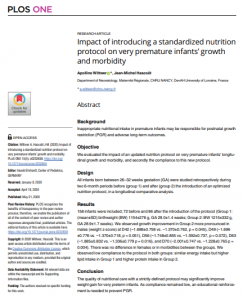
Background
Inappropriate nutritional intake in premature infants may be responsible for postnatal growth restriction (PGR) and adverse long-term outcomes.
Objective
We evaluated the impact of an updated nutrition protocol on very premature infants’ longitudinal growth and morbidity, and secondly the compliance to this new protocol.
Design
All infants born between 26–32 weeks gestation (GA) were studied retrospectively during two 6-month periods before (group 1) and after (group 2) the introduction of an optimized nutrition protocol, in a longitudinal comparative analysis.
Results
158 infants were included; 72 before and 86 after the introduction of the protocol (Group 1: (mean±SD) birthweight (BW) 1154±276 g, GA 29.0±1.4 weeks; Group 2: BW 1215±332 g, GA 28.9±1.7 weeks). We observed growth improvement in Group 2 more pronounced in males (weight z-score) at D42 (−1.688±0.758 vs. −1.370±0.762, p = 0.045), D49 (−1.696 ±0.776 vs. −1.370±0.718, p = 0.051), D56 (−1.748±0.855 vs. −1.392±0.737, p = 0.072), D63 (−1.885±0.832 vs. −1.336±0.779 p = 0.016), and D70 (−2.001±0.747 vs. −1.228±0.765 p = 0.004). There was no difference in females or in morbidities between the groups. We observed low compliance to the protocol in both groups: similar energy intake but higher lipid intake in Group 1 and higher protein intake in Group 2.